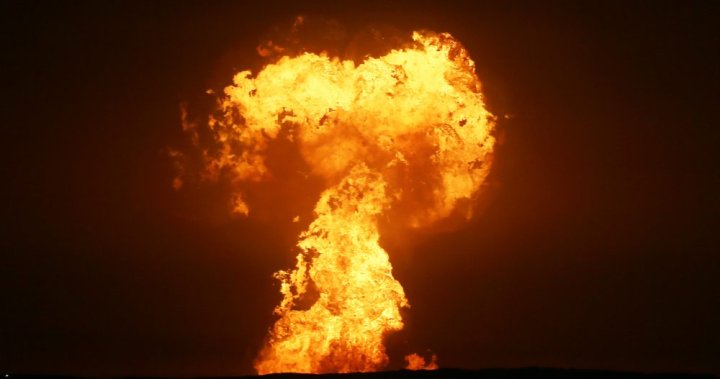An underwater explosion launched a towering column of fire into the sky over the gas-rich Caspian Sea on Sunday, in a stunning display said to have been caused by a so-called “mud volcano” in Azerbaijan.
Footage captured from the water and the air shows a bright mushroom cloud rising out of the Caspian Sea on July 4 in a spectacular and unexpected eruption.
Read more:
Humpback whale swallows up diver, then spits him out alive
The Caspian Sea is home to many offshore gas platforms, though SOCAR, Azerbaijan’s state energy company, insists that it had nothing to do with the blast.
“No incidents have happened at the offshore fields and industrial structures controlled by SOCAR,” spokesman Ibrahim Akhmedov said. “Work continues normally.”
SOCAR also rejected a claim by Azerbaijan’s Oil Workers’ Rights Protection Committee that a fire had broken out at an old exploration site at the Umid gas field.
SOCAR says the explosion was caused by a mud volcano — one of hundreds that lurk below the surface of the sea. The company located the mud volcano on a tiny uninhabited island called Dashly.
The mud volcano was still burning on Monday morning, but Azerbaijan’s Emergency Ministry said it did not pose a threat to people or the nearby oil and gas operations.
A strong explosion occurred in the Caspian Sea near the coast of Azerbaijan’s capital city of Baku, Azerbaijan on July 4, 2021.
Ministry of Emergency Situations/Anadolu Agency via Getty Images
Mud volcanoes are rare and poorly understood geological phenomena involving intense pressure and heat in the subsurface of the Earth. This pressure builds up and eventually blows in an explosion of silt, clay, mud, methane or natural gas.
Most mud volcanoes are typically quite small, but some of the world’s largest are in Azerbaijan, according to the U.S. Geological Service. These mega mud volcanoes can measure up to 9.7 kilometres wide and around 100 metres high.
Read more:
Stunning photos show solar eclipse as a ‘ring of fire’ over Canada
It’s unclear what might have ignited Sunday’s eruption, but it’s plausible that it was caused by a mud volcano, according to Mark Tingay, a professor who studies the phenomenon at the University of Adelaide in Australia.
Azerbaijan is known as the “Land of Fire” because of its rich oil and natural gas reserves — some of which occasionally catch fire.
This latest eruption came just a few days after the surface of the Gulf of Mexico caught fire due to an underwater pipeline leak.
—With files from The Associated Press
© 2021 Global News, a division of Corus Entertainment Inc.
















































